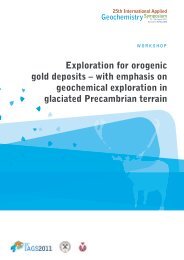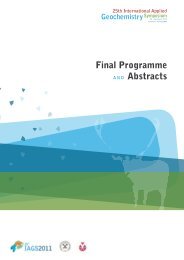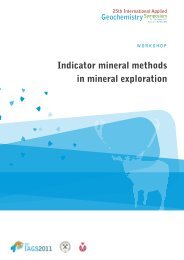Active and ongoing gold exploration and mining in ... - IAGS 2011
Active and ongoing gold exploration and mining in ... - IAGS 2011
Active and ongoing gold exploration and mining in ... - IAGS 2011
You also want an ePaper? Increase the reach of your titles
YUMPU automatically turns print PDFs into web optimized ePapers that Google loves.
Epigenetic <strong>gold</strong> m<strong>in</strong>eralisation <strong>in</strong><br />
central <strong>and</strong> SW F<strong>in</strong>nish Lapl<strong>and</strong><br />
More than 60 drill<strong>in</strong>g-<strong>in</strong>dicated, epigenetic <strong>gold</strong><br />
occurrences have been discovered <strong>in</strong> the Palaeoproterozoic<br />
greenstone belts <strong>in</strong> the central <strong>and</strong> SW<br />
F<strong>in</strong>nish Lapl<strong>and</strong>. Suurikuusikko (Kittilä M<strong>in</strong>e, Table<br />
1), be<strong>in</strong>g the largest deposit so far discovered,<br />
is a classic example of a <strong>gold</strong>-only orogenic deposit<br />
hosted by a N-trend<strong>in</strong>g shear zone <strong>in</strong> lower-greenschist<br />
facies greenstones (Eilu & Pankka 2009).<br />
Nearly all occurrences <strong>in</strong> Central Lapl<strong>and</strong><br />
probably belong to the orogenic category <strong>in</strong> the<br />
sense the deposit class is def<strong>in</strong>ed by Groves et al.<br />
(1998) <strong>and</strong> Goldfarb et al. (2001). For example,<br />
more than 30 drill<strong>in</strong>g-<strong>in</strong>dicated deposits <strong>and</strong> occurrences<br />
are <strong>in</strong> the Sirkka Shear Zone <strong>and</strong> subsidiary<br />
faults branch<strong>in</strong>g from this crustal-scale, >100 km<br />
long, structural break with<strong>in</strong> the Central Lapl<strong>and</strong><br />
greenstone belt <strong>in</strong> F<strong>in</strong>l<strong>and</strong> (Eilu et al. 2007). Locally,<br />
the two most significant controls to m<strong>in</strong>eralisation<br />
are structure <strong>and</strong> rock type: the ore bodies typically<br />
are hosted by the local dilatational sites <strong>and</strong> by the<br />
locally most competent lithological units. For many<br />
Pahtavaara Gold M<strong>in</strong>e<br />
Nicole L. Patison<br />
Agnico-Eagle F<strong>in</strong>l<strong>and</strong>, Kittilä, F<strong>in</strong>l<strong>and</strong><br />
V. Juhani Ojala<br />
Store Norske Gull AS, Longyearbyen, Norway<br />
Pasi Eilu<br />
Geological Survey of F<strong>in</strong>l<strong>and</strong>, Espoo, F<strong>in</strong>l<strong>and</strong><br />
Introduction<br />
Pahtavaara is an active <strong>gold</strong> m<strong>in</strong>e with a total <strong>in</strong> situ<br />
size estimate of 12.5 t <strong>gold</strong> (production + resource,<br />
as of January <strong>2011</strong>; F<strong>in</strong>nish M<strong>in</strong>istry of Employment<br />
<strong>and</strong> the Economy official statistics, Lappl<strong>and</strong><br />
Goldm<strong>in</strong>ers <strong>2011</strong>. Initial production took place dur<strong>in</strong>g1996–2000<br />
<strong>and</strong> the m<strong>in</strong>e was reopened <strong>in</strong> 2003<br />
(Eilu & Pankka 2009). The deposit is hosted by an<br />
altered komatiitic sequence at the eastern part of the<br />
Central Lapl<strong>and</strong> greenstone belt (Fig. 2 <strong>in</strong> Introduction<br />
<strong>and</strong> Fig. 4 below). It comprises of a swarm of<br />
subparallel lodes; nearly all <strong>gold</strong> is free native. It<br />
has many of the alteration characteristics of amphibolite-facies<br />
orogenic <strong>gold</strong> deposits <strong>and</strong> an obvious<br />
structural control, but has an anomalous barite-<strong>gold</strong><br />
lodes, part of the local control is <strong>in</strong>tersection of two<br />
faults or a fault along boundary between lithological<br />
units with contrast<strong>in</strong>g competence (Sorjonen-Ward<br />
et al. 2003, Holma & Ke<strong>in</strong>änen 2007, Patison 2007,<br />
Saalmann & Niiranen 2010). Fluid compositions<br />
(Billström et al. <strong>in</strong> press) suggest variable, mixed,<br />
orig<strong>in</strong>s for volatiles <strong>and</strong> metals with no obvious <strong>in</strong>dications<br />
of a local source. These features are present<br />
for both the <strong>gold</strong>-only <strong>and</strong> the anomalous metal<br />
association (typically Au-Cu) subtypes. Obvious<br />
IOCG-type deposits have been detected only <strong>in</strong> the<br />
westernmost F<strong>in</strong>nish Lapl<strong>and</strong>, <strong>in</strong> the western marg<strong>in</strong><br />
of the Central Lapl<strong>and</strong> greenstone belt. The IOCG<br />
deposits are covered by another field excursion of<br />
the <strong>IAGS</strong> congress <strong>and</strong>, hence, not discussed here.<br />
A possible exception to the orogenic type<br />
of <strong>gold</strong> m<strong>in</strong>eralisation with<strong>in</strong> the Central Lapl<strong>and</strong><br />
greenstone belt is represented by the Pahtavaara<br />
<strong>gold</strong> deposit. Pahtavaara has an anomalous barite<strong>gold</strong><br />
association <strong>and</strong> a very high f<strong>in</strong>eness (>99.5%<br />
Au) of the <strong>gold</strong>. Furthermore, the geometry of<br />
high-grade quartz-barite lenses <strong>and</strong> amphibole<br />
rock bodies relative to biotite-rich alteration zones<br />
is anomalous to an orogenic or an IOCG deposit.<br />
association <strong>and</strong> a very high f<strong>in</strong>eness (>99.5 % Au)<br />
of <strong>gold</strong> (Kojonen & Johanson 1988, Korkiakoski<br />
1992). The geometry of high-grade quartz-barite<br />
lenses <strong>and</strong> amphibole rock bodies relative to biotiterich<br />
alteration zones is also anomalous, as is the δ 13 C<br />
of alteration carbonate m<strong>in</strong>erals. Pahtavaara is best<br />
<strong>in</strong>terpreted as a metamorphosed seafloor alteration<br />
system with ore lenses as either carbonate- <strong>and</strong> barite-bear<strong>in</strong>g<br />
cherts or quartz-carbonate-barite ve<strong>in</strong>s<br />
(David Groves, pers. comm. 2006). The <strong>gold</strong> may<br />
have been <strong>in</strong>troduced later, but its gra<strong>in</strong> size, textural<br />
position (nearly all is free, native, <strong>and</strong> occurs<br />
with silicates, not sulphides) <strong>and</strong> high f<strong>in</strong>eness po<strong>in</strong>t<br />
to a pre-peak metamorphic tim<strong>in</strong>g which is highly<br />
anomalous for orogenic <strong>gold</strong>.<br />
Geology <strong>and</strong> hydrothermal alteration<br />
The follow<strong>in</strong>g description is extracted from<br />
Korkiakoski (1992) unless otherwise is <strong>in</strong>dicated.<br />
Pahtavaara <strong>gold</strong> m<strong>in</strong>e is hosted by the predom<strong>in</strong>antly<br />
pyroclastic Sattasvaara komatiite complex with<strong>in</strong><br />
the Sattasvaara Formation of the Central Lapl<strong>and</strong><br />
greenstone belt. There is no reliable radiometric age<br />
data of the volcanic rocks of the Sattasvaara Formation<br />
<strong>in</strong> F<strong>in</strong>l<strong>and</strong>, but one of its branches cont<strong>in</strong>ues far<br />
<strong>in</strong> northern Norway where Krill et al. (1985) have<br />
19






